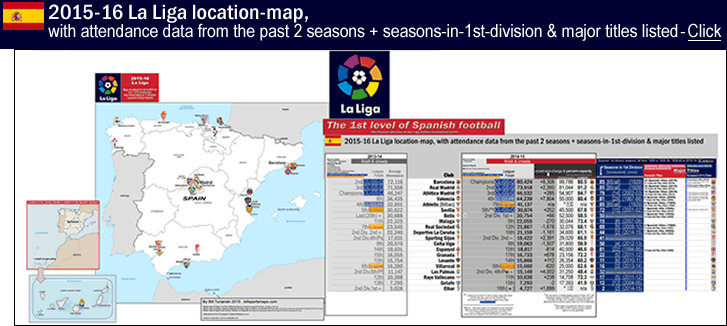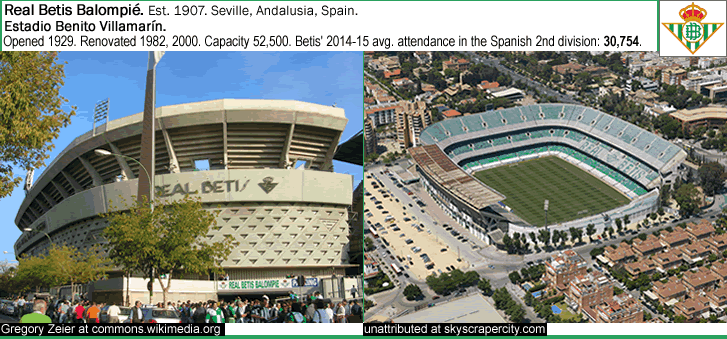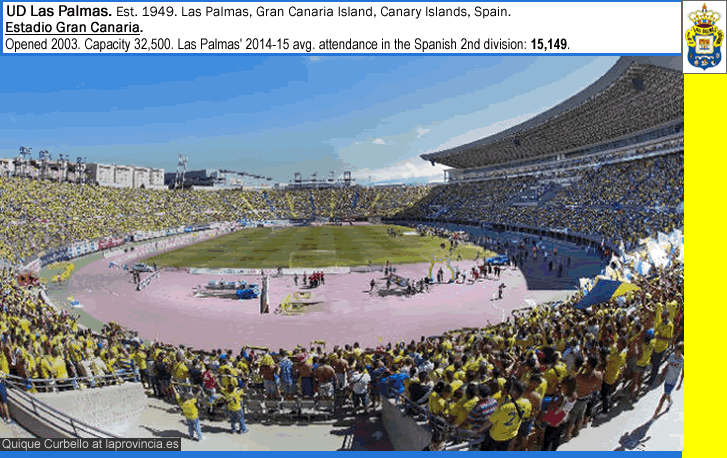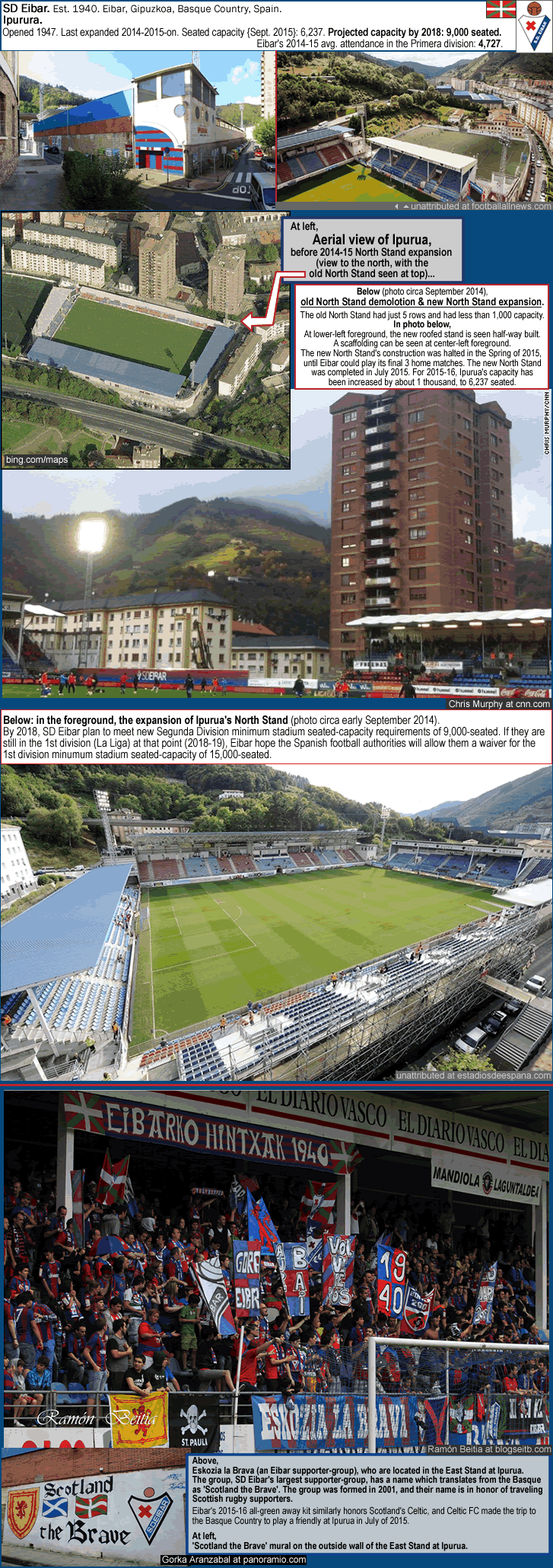Note: to see my latest map-&-post of Spanish football, click on the following, category: Spain.
.
.
.
.
.
.
.
.
.
.
.
.
.

Spain: 2015-16 La Liga location-map, with: 14/15 attendance data, seasons-in-1st-division-by-club & major titles listed
…
…
Links…
-Teams, etc…2015–16 La Liga (en.wikipedia.org).
-Fixtures, results, table, stats…Primera División (soccerway.com/national/spain/primera-division).
-Here is a great blog which I have had on my blogroll here since 2007…Spanish Football & Sports blog (spanishfootballsports.blogspot.com).
-Football Espana site…football-espana.net.
By Bill Turianski on 7 September 2015; twitter.com/billsportsmaps.com.
On the map page…
The map page features the same template as my recent Germany and England top flight map-&-posts. Cities listed on the map comprise the 5 largest cities (metro-areas) in Spain (Madrid, Barcelona, Valencia, Seville, Bilbao…all Spanish cities with a metro-area population over .9 million) {source: List of metropolitan areas in Spain (en.wikipedia.org).
…
-
The 3 clubs Promoted from the 2014-15 La Segunda to La Liga for 2015-16:
Betis, Sporting Gijón, and Las Palmas/
(+ 18th-place Eibar, who were re-instated following Elche’s expulsion from La Liga for tax delinquency)
2014-15 Segunda División champions…
Betis. Real Betis Balompié S.A.D., est. 1907.
Seville, Andalusia, Spain.
Ground: Estadio Benito Villamarín. Capacity 52,500 seated (capacity lowered from actual-seated-capacity of 56,500). Opened 1929; last renovated 1997-2000.
Seasons that Betis have spent in La Liga [the Spanish 1st division]: 50 seasons [counting 2015-16]. Previous spell in Spanish 1st division: a 3-season spell, from 2010-11 to 2013-14.
Major titles: 1 Spanish title (1934-35). (Zero Copa del Rey titles.)
Estadio Benito Villamarín…

Photo credits above -
Exterior shot: by Gregory Zeier at File:Stade Manuel Ruiz de Lopera Séville.JPG (commons.wikimedia.org).
Aerial shot, unattributed at skyscrapercity.com/thread-[SEVILLA - Estadio Benito Villamarín (56,500) ].
Squad info, etc…-2015-16 season preview: Betis.
The bright-green-&-white clad Betis have had three spells in the second division in the last 15 years {en.wikipedia.org/Real_Betis/team statistics}. Betis are probably one of the 5 or 6 biggest yo-yo clubs in all of Europe (“up there” with Hertha Berlin, FC Köln, FC Nürnberg, Sunderland, FC Kaiserslautern, RC Lens, Norwich City, Wolverhampton, Sporting Gijón, and Bologna). Betis is a club which can draw between 34-and-37 K in decent seasons (such as in 2011-12 and 2012-13), and can actually draw as high as 30 K when they are stuck in the 2nd division (like they did in 2014-15, en route to the Segunda División title).
When Betis are in the top flight, it seems that they are constantly battling for their first division life. It just seems that way, though, because Betis can actually pull off a great season now and then, such as in 2012-13 when they finished 7th and then qualified for the 13/14 UEFA Europa League; and especially such as in 2004-05, when they finished 4th and then qualified for the 05/06 UEFA Champions League Group Stage (that made Betis the first Andalusian team to play in the rarefied air of the Champions League Group Stage).
The biggest impediment to Betis’ success in the last two decades has been their felonious and monstrously corrupt former owner Manuel Ruiz de Lopera – who entered the scene in 1992, helped get Betis’ much-too-large stadium re-built in 2000, grandiosely got the stadium named after him…then in 2006 was sentenced to a two-and-a-half year prison term for embezzlement of over €30 million. At the Betis fansite BlogBetis.com, at their article The History of Betis, it is recounted how…{excerpt}…”In 2006 he [Manuel Ruiz de Lopera] was found guilty of ‘financial irregularities’ by Spain’s Inland Revenue between 1996 and 1997. From his tenure at Betis, he is alleged to have taken €36 million from the club – roughly half the amount of debt he left the club in. He basically contracted out Betis’ employees and services to his own personal companies and properties, for a vastly inflated fee.”
Although Betis can and do outdraw local rivals Sevilla in some seasons (such as in 2011-12 & 2012-13), they still suffer from a deficit of attention due to the presence of FC Sevilla there in the capital of Andalusia. So you might say that the second biggest problem Betis has had in the modern era is that the club suffers from the ‘Sheffield syndrome’, which is my term for a city which would probably be better off if just one medium-large club, as opposed to two medium-large clubs, existed there. Maybe I am wrong and Seville is a city big enough and football-focused enough to swing two quasi-contender-top-tier clubs, but I think that Spanish football would be a more competitive affair in the present-day Real/Barca duopoly if only one title-contender had ever emerged from Seville (which is Spain’s fourth-biggest city, with a metro-population of around 1.2 million/ see this, List of metropolitan areas in Spain). Like it is with respect to Spain’s 3rd-largest city, Valencia, a city which does have 2 top-flight clubs, but of the two, only Valencia CF is big enough to compete for trophies, while Levante is simply happy to avoid the drop on the few occasions in which they have been in La Liga.
…
2014-15 Segunda División runner-up…
Sporting Gijón. Real Sporting de Gijón, S.A.D., est. 1907.
Gijón, Asturias, Spain.
Ground: El Molinón. Capacity: 30,000. Opened 1908; last renovated 1997 and 2008.
Seasons that Gijón have spent in La Liga [the Spanish 1st division]: 41 seasons [counting 2015-16]. Previous spell in Spanish 1st division: a 4-season spell, from 2007-08 to 2011-12.
Major titles: none.
El Molinón…

Photo credits above –
Aerial shot: unattributed at ea1fft.es.tl/SPORTING-DE-GIJON.
Interior shot: by Sporting Gijón at realsporting.com.
Squad info, etc…-2015-16 season preview: Sporting Gijon.
Gijón wear Atletico-Madrid-style colors (red-and-white striped jerseys and bright-royal-blue pants). As alluded to in the section above, Sporting Gijón are probably one of the 9 or 10 biggest yo-yo clubs in Europe…while not as high-drawing as Betis, Gijón can draw 21 K in the top tier and around 17-19 K in the second division. They, like Betis, have won 3 promotions in the era of the 2000s. Gijón’s best finish was in 1978-79, when they were runner-up, finishing 4 points behind Real Madrid. Situated in the north of Spain on the Bay of Biscay, about equidistant from Bilbao on the east and La Coruna on the west, Gijón is in the Autonomous Community of Asturias. The metropolitan area of Oviedo–Gijón–Avilés is the 7th-largest metro-area in Spain, with about 840,000 population {2007 estimate}. (Oviedo, the capital of Asturias, is about 8 miles south of Gijón).
Sporting Gijón boasts a fine stadium, the venerable 30-K-capacity El Molinón. This is a proper Spanish-style stadium with seats right up against the pitch, and with the corners filled in, yet with four distinct and staggered-sized stands, some of which are at a viewer-friendly high-pitched-angle. (It sort of looks like a smaller St James’ Park [Newcastle], without all the erector-set-cantilver bracing.) As it says in the stadium’s Wikipedia page, “El Molinón is the oldest professional football field in Spain. It has been in use since at least 1908, and is located on the site of an old watermill, hence the stadium’s name, the Asturian word for “big mill”…”
…
2014-15 Segunda División play-offs finals winner…
Las Palmas. Unión Deportiva Las Palmas S.A.D., est. 1949.
Las Palmas, Gran Canaria Island, Canary Islands, Spain.
Ground: Estadio Gran Canaria. Capacity: 32,150. Opened: 2003.
Seasons that Las Palmas have spent in La Liga [the Spanish 1st division]: 32 seasons [counting 2015-16]. Previous spell in Spanish 1st division: a 2-season spell, from 2000-2002.
Major titles: none.
Estadio Gran Canaria…

Photo credit above – by: Quique Curbello at laprovincia.es/deportes/2014/11/07/luz-verde-iniciar-obras-graderio.
Squad info, etc…-2015-16 season preview: Las Palmas.
There are two clubs from the Canary Islands which have had top flight experience: the dark-blue clad Tenerife (from the Island of Tenerife) and the royal blue-and-yellow clad Las Palmas (from the Island of Gran Canaria). It is hard to say which of the two are a bigger club, because their crowd sizes vary so much from season-to-season, depending on how well the clubs are doing (the clubs draw within a wide ~9-K-to-19-K-range in 2nd division; although Tenerife were stuck in the 3rd division for a season recently, and last season Tenerife only drew 9.6 K). Tenerife have spent 13 seasons in La Liga (last in 2009-10, when they drew 18.0 K); Las Palmas now will have spent 32 seasons in La Liga (previously in 2001-02, when they drew 16.4 K). I would have to give the nod to Las Palmas as being the biggest club from the Canary Islands. I think Las Palmas will be drawing around 20 K in 2015-16 – as long as they can remain outside the relegation-zone, or at least be showing a solid chance of avoiding the drop (which might be too big an ask).
The biggest obstacle that Canary Islands-based clubs face is the sheer isolation of the Canaries from mainland Spain. Las Palmas, Gran Canaria is 1,750 km (1,090 mi) from Madrid ! You can imagine how hard it would be for Canary Islands-based clubs to lure good Spanish mainlanders to play for them…for all intents and purposes, the Canary Islands in this respect could be seen as Spain’s tropical Siberia. An example of what this means vis-a-vis rosters for Canary-Islands-based-teams is that in their successful 14/15 promotion-campaign, no less than 90% of the Las Palmas squad were Canary-Islands-born. Anyway, after a wrenching Segunda División 13/14 play-offs finals loss (to Córdoba), Las Palmas shrugged off that set-back and made the play-offs again in 2014-15, as 4th place finishers. Then in the Segunda División 14/15 play-offs, Las Palmas defeated Valladolid in the semis, and then defeated Zaragoza in the finals, thanks to a dramatic and acrobatic 86th-minute goal by then-Boca Juniors loanee Sergio Araujo. That match was played at Estadio Gran Canaria, with 28 K in attendance. Araujo (age 23) has now signed with Las Palmas.
Las Palmas were last in La Liga 13 seasons ago, during a 2-season top flight spell that ended in 2002. Back then, Las Palmas were drawing between 16.4-and-17.2 K as a top flight club. They have a new stadium now. Talk about bad timing, though…Las Palmas were relegated down to the 2nd division the year before the 32,000-capacity Estadio Gran Canaria was opened (in 2003). Talk about bad planning, too, because the folks who run these things out there in the Canary Islands did not get the memo that says that ALL football fans detest stadiums with stupid, useless, and atmosphere-destroying running tracks. So, another decent stadium in the Latin lands ruined by an idiotic running track (sigh). In the photo above, just look at that soul-destroying and yawning +60-foot gap between the stands behind the goal there [in the foreground], and the pitch. Sheesh, you’d need binoculars from the first row.
…
And finally…
Re-instated (as 18th-place finishers), into La Liga for 2015-16, following Elche’s expulsion for violating 1st division financial criteria…
SD Eibar. Sociedad Deportiva Eibar, S.A.D., est. 1940.
Eibar, Gipuzkoa, Basque Country, Spain.
Ground: Ipurua. Capacity: 6,237 for La Liga matches (as of Sept. 2015). Opened: 1947; last renovation – currently ongoing (2014-2015-onward to ~2018).
Seasons that Eibar have spent in La Liga [the Spanish 1st division]: 2 seasons [counting 2015-16].
[Note, Eibar is pronounced "A-bar".]
Squad info, etc…-2015-16 season preview: Eibar (football-espana.net).
Basque Country side SD Eibar were shock-promotion-winners in 2014 (when they drew 3.0 K in the 2nd division in their tiny, then-5.2-K-capacity stadium). Eibar became the smallest-ever club to play in La Liga. They started the 2014-15 La Liga season very strong (and were in 7th place in early December 2014), but they then went through a horrible run that saw them winless in 7 and then into the relegation places by March 2015. They rallied, but it wasn’t enough. But if Eibar played in England, Germany, Italy, or France (or most any other place in Europe), they would have automatically stayed up last season – because all those leagues sensibly use Goal Difference as the first tie-breaker for league table placement, and Eibar had a better goal difference than the other two clubs they were even on points with. But Spain uses the ant-democratic Head-to-Head as first tiebreaker. How elitist. Spain is saying that when teams are dead-locked on points total at the end of the season, the league as a whole is secondary – the issue of settling who finishes above whom is only an issue between the two clubs who are tied. Or the three clubs who are tied. Etc. (Try following that at home.)
Which is what happened on the final day of the 2014-15 La Liga season, when Deportivo La Coruña, Granada, and Eibar were all deadlocked at 35 points…and one of those three had to end up in 18th place, and thus be relegated. And the Head-to-Head records were: Deportivo with 7 pts, Granada with 6 pts, Eibar with 2 pts. So Eibar were relegated back to La Segunda on 15 May 2015.
Then three weeks later, on 5 June 2015, Eibar got a reprieve. Another La Liga club – Elche, of Valencia province – ended up running afoul of financial rules (tax delinquency), so the 13th-place-finishing Elche were relegated instead. In the Spanish top flight, tax debt is not necessarily a punishable offense, but the failure of a club to provide a re-payment-plan with a time-table, well, that is a punishable offense, and tax-delinquent Elche was punished with automatic relegation to the 2nd division. {See this article, by Tim Stoddard at FourFourTwo.com for more on that, Did Elche get their just deserts with demotion?.}
This made room for the highest-placed relegated club, and that was SD Eibar, the plucky little club from the small town of Eibar in the looming foothills of the Pyrenees (population 28,000). So Eibar remains in the top flight, and just in time for SD Eibar to start off their 75th Anniversary season in grand style…Celtic, the Scottish giants, accepted an invitation to play a friendly at Ipurua in July of 2015 {see third article linked to in the next paragraph, and see Eibar’s Scottsh connection in the last photo and caption in the illustration further below}. Then in late August, Eibar went out and started the 2015-16 La Liga season by beating Granada away (by a 1-3 score), and then they beat Basque giants Athletic [Bilbao] 2-0, at Ipurua, in front of 5,500.
Here are a couple nice, illustrated articles on Eibar’s little gem of a stadium, Ipurua (current capacity 6,237 seated), plus a recent article on Eibar’s Scottish connection…
-From Footballallnews.com, 2014-2015 La Liga Stadium Tour: Eibar – Ipurua
-From The Basque Pass.com, from 29 June 2015, by Euan McTear, THE LONG READ: Breaking Down Eibar’s Stadium Expansion.
-From The Herald (Scotland), from 17 July 2015, also by Eaun McTear, Bagpipes in the Basque: Why Celtic are playing Eibar this weekend (heraldscotland.com/sport).
Eibar’s expansion plan for Ipurua…
Construction scheduled from 2014-to-2018/ adding about 4,800 more seats to make Ipurua a 9-K-capacity ground…
By January 2018, SD Eibar plan to meet new Segunda Division minimum stadium seated-capacity requirements of 9,000-seated. If Eibar are still in the 1st division at that point (2018-19), the club hopes that the Spanish football authorities will allow them a waiver for the 1st division minimum stadium seated-capacity of 15,000-seated. As it is, there is scant room for further expansion of the ground because of how narrow the mountain-valley is, in which the town of Eibar is situated in. Large public housing occupies the land immediately behind the North Stand, and a highway is right up against the South Stand. Behind the West Stand (a goal stand) is the team’s training pitch, and behind the East Stand (another goal stand), there is more large public housing. {See aerial/bird’s-eye satellite view of Ipurua from Bing.com satellite-view, here (zoom using + sign at top-right, for bird’s-eye-effect); or see it in the illustration below.} There really is nowhere to forther expand Ipurua, unless public housing is torn down, or unless Eibar tears up their practice pitch. That is why I think Eibar will get the minimum-capacity waiver if it ever comes to that juncture. Besides, a 15-K-stadium for a town of only 28,000 is just plain crazy.
Ipurua…

Photo credits above –
Ipurua exterior shot (NE corner of the stadium, near old North Stand entrance) & interior shot (SW view towards the hills, SW of town): unattributed at footballallnews.com [stadium tour of Ipurua].
Aerial shot: bing.com/maps
Half-way built new North Stand: shot by Chris Murphy / CNN at ‘Miracle’ club Eibar a blueprint for soccer’s future? (cnn.com).
2015 Ipurua stadium expansion, photo: unattributed at estadiosdeespana.com/posts/eibar-ipurua.
Photo from Ipurua East Stand of the Eskozia la Brava fan group, shot by Ramón Beitia at blogseitb.com/eibar; eitb.eus/es/blogs.
Photo of Eskozia La Brava mural outside wall of East Stand, by Gorka Aranzabal at panoramio.com.
___
Thanks to all at the links below…
-Blank map of Spain, by NordNordWest, at File:Spain location map.svg (en.wikipedia.org).
-Blank map of Spain incl. Canary Islands [segment], by HansenBCN, at File:EspañaLoc.svg.
-Blank map of Spain incl. Canary Islands, by Miguillen, at File:España-Canarias-loc.svg.
-Attendances from E-F-S site, european-football-statistics.co.uk/attn.htm.
-2014-15 stadium capacities (for league matches) from 2014-15 La Liga (en.wikipedia.org).
-Titles and seasons-in-1st-division data from La Liga (en.wikipedia.org).
-Thanks to the contributors at 2015–16 La Liga (en.wikipedia.org).
-Thanks to Football-Espana.net, for the nice team previews; Football-Espana.net can be found at the blogroll here.
-Thanks to Euan McTear at The Basque Pass.com for the 2 excellent articles; The Basque Pass.com can be found at the blogroll here.
